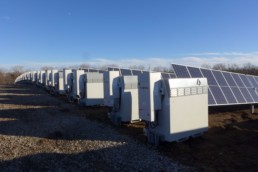Lloyd's Features NER in Report: Renewable Energy Risk and Reward- Risks and Technologies
Renewable Energy Risk and Reward: Risks and Technologies, co-produced by Lloyd's, Imperial College London, and Oxford Energy Associates, features NER on page 10. Scroll to the bottom of this webpage to download the full report.
The text of the NER feature is included here:
Performance insurance solutions for breakthrough technologies
Innovation comes with risk, but that should not stop companies from paving the road to the future. New Energy Risk (“NER”), a California-based MGU, works with pioneers in the new-energy arena to support technology breakthroughs, advancing the critical projects needed to accelerate the transition to sustainable energy. To do so, NER structures customised performance insurance products that seek to mitigate technology risk for clients, and their customers and lenders as a result.
NER-developed policies are underwritten and issued by one of the affiliated insurance companies of AXA XL (S&P AA-) and administered by its subsidiary Complex Risk and Insurance Associates, LLC, licensed in California (#0I24307). Policies stand behind the client’s technology performance and ultimately protect project debt-lenders or end-customers from certain losses associated with the underperformance of an asset. By incorporating a double-trigger mechanism—wherein the technology has to perform below a pre-determined, conservative threshold, and the technology provider has to default on performance warranties that match or exceed the insurance terms—the policy seeks to align the interest of developers, customers, and investors with the insurer to provide technology risk transfer to the insurer, without introducing moral hazard or misaligned incentives.
With a team of scientists and insurance professionals, NER has developed a data-driven methodology for evaluating technical risk, bringing a new class of diversified risk to the insurance market. The company’s proprietary modelling uses Monte-Carlo analysis techniques that simulate a range of potential project outcomes to assess uncertainty around performance and reliability of a client technology, including the impact on relevant economics. The result is well-structured and profitable packages delivered in conjunction with insurance partners, and client access to financing that is minimally dilutive and optimally priced.
In only five years, NER’s clients have already deployed over $2 billion in capital, supported by AXA XL’s insurance companies, and their global reinsurers, including various Lloyd’s syndicates. NER’s diverse and global client-base represents a wide range of technologies and industries, from fuel cells and waste-to-value to nuclear medicine, all focused around the mission of mitigating global challenges through smart business. Clients include:
- Fulcrum BioEnergy, a trash-to-biofuel developer building their first commercial facility in the US;
- Bloom Energy, the leading supplier of solid-oxide fuel cells for reliable, resilient, and cost-effective on-site electricity;
- RES Polyflow, an innovative plastic waste-to-fuel technology company building a recycling project in the US; and
- SHINE Medical Technologies, a development-stage company working to become the world’s leading producer of medical isotopes.
Learn more about New Energy Risk at www.NewEnergyRisk.com
###
New Energy Risk, SHINE Medical Technologies Partner on Innovative Insurance Solution That Supports Financing of One-of-a-Kind Nuclear Medicine Facility
MENLO PARK, Calif., March 10, 2020 /PRNewswire/ -- New Energy Risk (NER), one of the leaders in customized insurance solutions for breakthrough technology projects, today announced that it has provided SHINE Medical Technologies, a development-stage company working to become the world's leading producer of medical isotopes, with an innovative performance insurance program for SHINE's groundbreaking production facility. The insurance solution provided by NER is a key component of SHINE's project financing and execution strategy.
SHINE's patented, proprietary isotope production process uses a safe, cost-effective and environmentally friendly technology to produce a variety of medical isotopes, including molybdenum-99, or Mo‑99, which is relied on for more than 40 million medical procedures every year. Roughly one percent of all Mo-99 in the world decays every hour, so it must be produced continuously. Current production is limited to a handful of government-owned nuclear research reactors, the majority of which are overseas. SHINE's facility will be the first non-reactor producer of Mo-99 in the United States. The facility will be capable of satisfying one-third of global patient need for Mo-99. SHINE's use of fusion technology solves the major problems caused by limited access to nuclear reactors and provides the potential to improve the lives of more than 1 billion people during the next 50 years.
To finance this development, SHINE raised capital from Deerfield Management Company and Oaktree Capital Management L.P., and approached NER, an affiliate of the global insurance group AXA XL, to design a custom performance insurance policy that would mitigate technology risk in this revolutionary project. NER utilized its proprietary technoeconomic analysis to extensively assess SHINE's technology, then developed an insurance product and monitoring schedule that covers the commissioning and output of the facility. This is the first time such a performance insurance product has been designed for a private medical isotope technology.
"2019 was SHINE's best year yet from a project finance and execution standpoint," said Greg Piefer, founder and CEO of SHINE Medical Technologies. "New Energy Risk's technology insurance solution was an important element of our success in 2019 and we are thrilled to be partnering with New Energy Risk on this unique approach."
"We're proud to have supported SHINE in their capital raise and are thrilled to apply our bespoke insurance solution for the first time in a critical medical field," said Tom Dickson, CEO of NER. "We are on a mission to partner with breakthrough technologies solving pressing global challenges, and SHINE is among the most impactful and exciting companies we have had as a client."
This project is among NER's growing portfolio of industrial projects that have cumulatively raised more than $2 billion in capital. Apart from the production of medical isotopes, NER's diverse clients have also planned to deliver or process annually: 441 thousand tons of recycled waste, 640 million kWh of energy, 50 million gallons of non-petroleum fuels, and 314 thousand tons of avoided CO2e.
About SHINE Medical Technologies LLC
Founded in 2010, SHINE is a development-stage company working to become a manufacturer of radioisotopes for nuclear medicine. The SHINE system uses a patented, proprietary manufacturing process that offers major advantages over existing and proposed production technologies. It does not require a nuclear reactor, uses less electricity, generates less waste, and is compatible with the nation's existing supply chain for Mo-99. In 2014, SHINE announced the execution of Mo-99 supply agreements with GE Healthcare and Lantheus Medical Imaging. In 2015, with the help of Argonne National Laboratory, GE Healthcare demonstrated that SHINE Mo-99 can act as a drop-in replacement for reactor-based Mo-99. In 2016, SHINE received regulatory approval from the Nuclear Regulatory Commission to construct its production facility. The company began construction of the facility in the spring of 2019. SHINE has raised more than $350 million from investors and government sources.
About New Energy Risk
New Energy Risk is a pioneer of large-scale, breakthrough technology performance insurance solutions. Founded in 2010, the company provides complex risk assessment and serves as a bridge between technology innovators, financiers, and insurers. New Energy Risk has helped its customers raise over $2 billion in financing for commercializing renewable energy and new technology deployments. Insurance policies are administered through New Energy Risk affiliate Complex Risk and Insurance Associates, LLC, CA License #0I24307. To learn more, visit www.newenergyrisk.com.
About AXA XL
AXA XL, the property & casualty and specialty risk division of AXA, provides insurance and risk management products and services for mid-sized companies through to large multinationals, and reinsurance solutions to insurance companies globally. We partner with those who move the world forward. To learn more, visit www.axaxl.com
Flow batteries scale up to GW production
Originally published in the September 2019 edition of PV Magazine
By Benedict O’Donnell
Plans for a gigawatt factory in Saudi Arabia, bullet-proof warranties and an international vanadium rental service are propelling a new generation of batteries into the energy storage big league. Pioneers of redox flow technology claim that they can put an end to the degradation and safety issues afflicting lithium-ion batteries. They also expect imminent economies of scale to reduce the cost of bulk energy storage and unlock new markets for solar power.
...
A new cavern of wonders is rising from the sands of Saudi Arabia. A century after transforming the global energy sector with cheap, abundant oil, the Kingdom is now building the first gigawatt-scale factory for redox flow batteries, a technology that proponents argue will slash the price of storing solar energy.
Since the basic patent protecting redox flow batteries expired just over a decade ago, dozens of tech firms have raced to develop the technology and drive down its cost. In many respects, they have succeeded. Matt Harper, president of Avalon Battery, says that prices offered by leading manufacturers have come down 80% in less than five years. Lazard, an asset manager, calculates that the levelized cost of storing electricity in some redox flow projects now overlaps with that of lithium-ion batteries, the main competition. This year, sales of vanadium-flow batteries, the most established redox flow technology on the market, have grown from double digits to just over 200 MWh of installed storage capacity.
In spite of these achievements, Alex Eller, an analyst at Navigant, points out that redox flow batteries have yet to dent the energy market. He says that most of the 7,000 MWh of grid scale storage coming online this year will be met by lithium-ion batteries, followed by pumped hydro and other established storage technologies, with flow batteries trailing behind.
“Flow battery projects have so far been relatively small scale,” said Eller. “We are only just starting to see large-scale commercial projects in the works.” While he sees many hurdles still facing the emerging redox flow industry, Eller is also convinced of the technology’s potential to reduce the cost of storing renewable energy.
Zero degradation
Undercutting the record-low prices set by lithium-ion batteries will be no small challenge. In recent years, global electronics brands including Samsung, LG and Panasonic have streamlined assembly lines capable of producing gigawatt-hours of lithium-ion batteries each year. Prices have come down faster than expected and sluggish demand for electric vehicles has led to a glut of cells now being sold at cutthroat prices to store power on the grid.
Fierce as this competition may be, flow batteries have an ace up their sleeve. Unlike the lithium-ion batteries they compete with, their electrolytes do not degrade. According to Richard Wills at the University of Southampton, what sets the technology apart is its architecture. Rather than distribute electrolytes within each cell, a flow battery separates electrolytes into external tanks and pumps the liquid through active elements that store and deliver energy. At first glance, the device looks more like a chemical treatment plant than an AA battery.
Redox flow technology raises new challenges. To function, these batteries require pumps and aqueous electrolytes that suffer from comparatively low energy densities. They also reduce the efficiency of the energy conversion process, they are unwieldy for most forms of transport, and they increase the floor space needed to house components.
But Wills says that redox flow technology can also charge and discharge batteries without degrading their performance. “The reactions undergone in redox flow batteries are surface electron transfers which are less susceptible to degrade electrodes and current collectors,” said Wills, adding that the large volume of aqueous electrolyte pumped through the cell stack also helps dissipate heat, a key burden on materials and notorious fire hazard in lithium-ion batteries. Cooler operation leads to higher safety margins, longer equipment lifetime and lower maintenance costs. On paper, this makes flow batteries safer than Li-ion technology and cheaper over the duration of a storage project.
“We have run a vanadium flow battery through 24,000 hours of very aggressive cycles and still cannot measure any degradation on the battery’s performance,” said Alex Au, CTO of Nextracker. Three years ago, the U.S. tracker supplier added energy storage solutions to its catalogue Au tested more than 40 technologies in-house to select products compatible with lifelike fluctuations in demand on electricity grids. The vanadium flow batteries made by Avalon Battery made the cut. “They even boast less degradation and a better warranty than any solar module on the market today,” said Au.

Vanadium rental shop
Back at Navigant, Alex Eller says that the extended lifetime and dependability of flow batteries should in principle recommend the technology for secluded electricity generation assets, in particular solar arrays, keen on storing vast volumes of electricity for several hours until its value peaks on the wholesale market. But the limited track record of large-scale flow battery projects has so far limited their deployment.
“Flow batteries face a severe trust issue,” said Eller. He explains that the main companies buying batteries today are risk-averse project developers. These procurement teams want to make sure that the manufacturer of the battery they select still exists in ten years’ time in case they need to replace faulty purchases. As a result, they favor working with reputable lithium-ion behemoths, rather than upstart redox flow pioneers, regardless of the long-term cost projections of the project.
In a similar display of conservatism, no established lithium-ion manufacturer has so far ventured into the redox flow battery business. Eller ventures that their reluctance is caused by market uncertainty. It remains unclear which variant of redox flow technology will come out on top. “Flow batteries using vanadium electrolytes are very good, but vanadium is expensive,” he says. The cost of the raw material already inflates capital expenditure for vanadium flow projects by over 30% and investors fear that fluctuations in commodity prices could strangle supply chains.
Matt Harper at Avalon Battery claims that creative financing and vanadium leasing schemes are making vanadium flow projects more bankable. To reassure jittery buyers, manufacturers have started securing warranties from third parties. Insurers like New Energy Risk in the United States will cover falls in battery performance over the 20-year lifespan of a redox flow project, even if the battery manufacturer goes out of business. These contracts effectively guarantee returns from an energy storage project so that its developer can trust the insurer, even if they are still growing familiar with the manufacturer.
Likewise, business solutions are dampening the risk of vanadium supply chains by allowing clients and battery manufacturers to lease their electrolyte. Vanadium producers including Glencore and Bushveld Energy are prepared to rent out the metal and recycle it, shouldering part of the capital expense of the project. “The vanadium electrolyte does not degrade and can be fully recovered at the end of the battery’s life,” said Mikhail Nikoramov, CEO of Bushveld Energy.
Harper claims that these advances have brought the vanadium flow industry to the same inflection point that geared up lithium-ion manufacturers in the 1990s when consumer electronics entered mass production. So far, redox flow batteries have filled niche applications, typically where fire safety is of particular importance. But as its price verges on that of lithium-ion batteries, Harper expects redox flow technology to storm the stationary storage market. He calculates that this growth could reduce Avalon Battery’s prices below $40/MWh, turning solar into “a truly dispatchable asset, capable of displacing all other sources of electricity on the grid.” In his view, the key to cutting costs is a mature supply chain and standardization.
Saudi Qualität
This is good news for the 70,000-square meter factory taking shape in Saudi Arabia. Its opening in 2020 will deliver over 1 GWh of redox flow storage capacity to the market each year, bringing unprecedented economies of scale to an industry that has so far had to make do with tailor-made solutions as it contends with mass-produced competition.
The Saudi plant will churn out vanadium flow batteries developed by Schmid, a German PV equipment supplier with 150 years of experience in industrial engineering. The family business branched out into redox flow batteries in 2011, commercialized its first vanadium flow battery in 2014, and set out in search of partners to scale up production.
Schmid struck a deal this year with RIWAQ, a Saudi construction firm, and Nusaned Investment, a subsidiary of Saudi petrochemicals giant Sabic, which finances technologies supporting policies set out by Saudi authorities. In 2016, the Kingdom announced its Vision 2030 plan to reduce national dependence on oil revenues, notably through massive investment in renewables. The venture brings together some of the most venerable veterans in the flow battery industry with exceptionally deep pocketed investors.
“The new Schmid deal in Saudi Arabia is very exciting,” said Maria Skyllas-Kazacos, who invented redox flow technology in the 1980s. She adds that the plant “will definitely help to provide the production scale needed to further reduce costs.”
###
New Energy Risk Welcomes Strategic Hires to Drive Growth & Streamline Client Experience
SAN FRANCISCO, Sept. 26, 2019 /PRNewswire/ -- New Energy Risk, an affiliate of global insurer AXA XL, announced the appointments of Dr. Matt Lucas as Managing Director, Business Development and Dvorit Mausner as Director of Execution. The strategic additions of Dr. Lucas and Ms. Mausner come at an exciting time in New Energy Risk's evolution, as the company surpassed $1.99B in aggregate transactional value supported by its technology performance insurance solutions.
Tom Dickson, CEO of New Energy Risk, remarked that "as we look toward the future, New Energy Risk seeks to expand its business and associated benefits to novel technologies across new sectors and geographies, and provide support for a greater variety and size of projects. Matt and Dvorit joining our team is a pivotal moment for New Energy Risk as we expand into new technology sectors.
"As the renewable energy sector continues to explode, technology providers are increasingly looking to New Energy Risk to help take revolutionary technologies from development to deployment and commercial scale," Mr. Dickson added. "By bringing on Matt to lead business development and Dvorit to streamline operations, we expect to better serve an increasing number of clients with a more efficient process."
In his new role, Dr. Lucas will lead New Energy Risk's expansion into new technology sectors, geographies, and products. He brings both technical and commercial experience at large corporates and startups to New Energy Risk. He was previously a technology scout for a large corporation, then had operating experience in multiple hardtech university spinoffs, and exposure to public policy advising in the nonprofit sector. Dr. Lucas received his PhD from UC Berkeley in Mechanical Engineering.
Ms. Mausner will support the streamlining and management of the entire client experience. She brings experience scaling six previous operations across the for-profit, academic, and non-profit sectors. She has previously directed engagement for international fundraising and behavior-change campaigns and revitalized a 6,000 sq ft science makerspace. Ms. Mausner is also co-founder and partner of Temescal Brewing in Oakland. Most recently, she designed a pre-seed carbontech startup accelerator. Ms. Mausner studied at the University of Pennsylvania, where she earned a business certification from the Wharton School, a Master's in Philanthropy and Social Justice, and a Bachelor's in the Biological Basis of Behavior.
New Energy Risk has also promoted other personnel. Sherry Huang is now Chief Actuary, and Brentan Alexander assumes the role of Chief Commercial Officer in addition to his existing role of Chief Science Officer.
Visit the www.newenergyrisk.com/team to learn more about Dr. Lucas and Ms. Mausner, and to connect with New Energy Risk via [email protected].
About New Energy Risk
New Energy Risk is a leading provider of performance risk solutions for breakthrough energy technologies and a pioneer in the development of large-scale technology performance insurance. The company was founded in 2010 to provide complex risk assessment and serve as a bridge between technology innovators and insurers. Since then, New Energy Risk has supported project finance transactions in aggregate value of over $1.99 billion for renewable energy and new technology deployments. New Energy Risk is an affiliate company of AXA XL. To learn more, visit www.newenergyrisk.com.
About AXA XL
AXA XL provides insurance and risk management products and services for mid-sized companies through to large multinationals, and reinsurance solutions to insurance companies globally. We partner with those who move the world forward. To learn more, visit www.axaxl.com
##
New Energy Risk Backs $260M Plastics-to-Fuel Plant with Innovative Insurance Solution
New Energy Risk Backs $260M Plastics-to-Fuel Plant with Innovative Insurance Solution
SAN FRANCISCO — April 22, 2019 — New Energy Risk, the leader in customized insurance solutions for renewable technology projects, has provided RES Polyflow, a leading plastics-to-fuel technology company, with a performance insurance program for its ground-breaking Ashley, Indiana plant. The project will be the United States’ first commercial-scale plastics-to-fuel project. Once completed, the facility will convert 100,000 tons of plastic into 18 million gallons of fuel and six million gallons of wax annually. By working with New Energy Risk (NER), RES Polyflow has reduced the overall cost of project capital, increased the certainty of execution, and made the bond offering more attractive to investors.
To finance this deployment, RES Polyflow and its parent development company, Brightmark Energy, raised an aggregate amount of $260 million, including $185 million in Indiana green bonds, underwritten by Goldman Sachs & Co. To streamline the financing, the companies approached NER, an affiliate of the global reinsurance group AXA XL, a division of AXA, to design a custom performance insurance policy that would mitigate technology risk for financiers interested in investing in this revolutionary project. NER used a systematic, data-driven approach to extensively assess the company’s technology, then developed an insurance product that covers the overall waste conversion process of the plant.
RES Polyflow’s plastics-to-fuel pyrolysis process sustainably recycles waste that has reached the end of its useful life — including items that cannot readily be recycled, like plastic film, flexible packing, Styrofoam, and children’s toys. The Indiana plant superheats and then converts plastic into ultra-low sulfur diesel and naphtha blend stocks, as well as commercial grade wax. In the future, the output could be turned back into plastic, creating the world’s first circular technology for plastics.
“New Energy Risk’s technology insurance solution was a critical factor in completing the financing for this project,” said Jay Schabel, President of Brightmark Energy’s plastics division and of RES Polyflow. “We have worked closely with New Energy Risk to assess the technical aspects of our project and design an innovative insurance solution. NER’s involvement successfully lowered our capital cost and served to raise bondholder interest in the project.”
“We’re proud to have supported Brightmark and RES Polyflow in their capital raise and are excited to see their leading plastics-to-fuel technology convert plastic waste into millions of gallons of low-carbon fuels,” said Tom Dickson, CEO of New Energy Risk. “Brightmark is leading the way in providing a technology solution to the world’s plastic waste problem, while replacing traditional fossil fuels in the process. We look forward to continue supporting their work in the years to come.”
This project is the latest in a string of industrial renewable projects New Energy Risk has supported. In total, NER has now supported $1.6B in renewable project financing, which will lead to over 500,000 tons of waste processed into 50M gallons of biofuel every year.
About New Energy Risk New Energy Risk is a provider of performance risk solutions for breakthrough energy technologies and pioneer in the development of large-scale technology performance insurance. The company was founded in 2010 to provide complex risk assessment and serve as an effective bridge between technology innovators and insurers. Since then, New Energy Risk has helped its customers gain over $1.6 billion in financing for renewable energy and new technology deployments. To learn more, visit www.newenergyrisk.com.
About AXA XL
AXA XL, a division of AXA, provides insurance and risk management products and services for mid-sized companies through to large multinationals, and reinsurance solutions to insurance companies globally. We partner with those who move the world forward. To learn more, visit www.axaxl.com.
Bioproducts are Seeing Major Tailwinds in Renewable Tech
Bioproducts are Seeing Major Tailwinds in Renewable Tech
By Tom Dickson and Brentan Alexander
Has Silicon Valley forgotten about cleantech after failures in solar, wind and batteries? Not quite! Several new and exciting renewable technologies are coming to market. Read Tom Dickson and Brentan Alexander’s TechCrunch article on Bioproducts re Seeing Major Tailwinds in Renewable Tech. Yes, companies are learning are how to turn trash into cash.
Here’s an excerpt via TechCrunch:
Today, entrepreneurs are approaching the space head-on, and there are dozens of cutting-edge companies coming to market and breaking through with major projects and customers. Companies in the space can be divided between the developers like Fulcrum BioEnergy, Red Rock Biofuels, RES Polyflow and Envia, and the technology providers, such as TCG, TRI, Velocys and many others.
These companies are targeting a variety of waste types, including household garbage (plastics and organics), as well as agricultural waste (like wood) and livestock waste (like manure). Waste is then converted into various products, including synthetic crude oil, natural gas, electricity, refined products (from diesel to high-value waxes) and specialty chemicals.
The Attributes that Define the Increasingly Critical Data-As-A Service Industry. Data is valuable but if it “don’t make dollars it don’t make sense.”
How to Avoid Looking like Theranos when Building Breakthrough Technology
Insurance solution provides performance coverage for the output of Fulcrum’s garbage-to-fuels plant
By Dr. Brentan Alexander, Chief Science Officer, New Energy Risk
At New Energy Risk, we see many companies struggle to balance the competing needs of technology development and deployment. As with any industry, it’s a tug-of-war between the commercial imperative of demonstrating that all aspects of a technology are proven and the financial necessity of delivering product and building a revenue stream. By going to market too early, a company is likely to fail to find capital or customers. Going too late means having expended more time and money than necessary, and it’s possible the opportunity may have passed by.
Most companies have vastly different ideas for what they need to demonstrate, from a technology perspective, to reach their market. For hardware and industrial technology companies, there is little room for error because deploying at commercial scale requires raising significant capital to cover the large capex costs associated with the construction of manufacturing, processing, and energy facilities. Companies looking to self-develop projects generally need access to lower cost capital markets, primarily debt markets, to ensure project viability. Startups that sell their hardware need to scale beyond first-adopters and find big buyers with deep pockets. These markets are by definition risk-averse, with strict guidelines to ensure loans don’t go bad and capital expenditures aren’t squandered. So how much validation do new-to-the-world technologies need to convince hyper-skeptical banks and customers to lend or buy?
We’ve seen many entrepreneurs latch on to examples of irrational exuberance: with a good story and slick marketing, willing customers and investors can be found with little to no technology validation. In fact, our experience performing diligence on hundreds of capitally intensive technology companies shows the opposite: a business plan predicated on mythmaking and vaporware is a plan to fail. Technology should never appear to be a black box — financiers and customers do not want to bet on magic, despite the occasional counterexample. Rather, the path to capital involves leveraging technology testing in real-world conditions to demonstrate to others that the science and engineering are thoroughly understood and vetted.
In short: show it works in the real world and don’t fall for the Theranos trap!
Here are some of the most common mistakes in demonstrating a technology that we’ve seen erode the chances of securing financing or closing a sale:
Companies try to jump from the lab to commercial scale
Breakthrough technology companies make a mistake when they do not build pilot demonstration facilities or hardware with similar scale, features, and equipment as their end product. These companies will have a hard time convincing skeptical financiers that what they’re selling is going to work as described. In general, a per-unit scale-up of over 10x for key components of the technology will raise eyebrows and dampen enthusiasm. Exceptions can be made for proven kit from third parties, such as pumps and valving or standard operations like heat exchange. The expected duration of a test campaign is dependent on the technology and expected maintenance cycle: once-through systems or systems with independent unit operations will need less time on test than systems with recirculation loops or highly integrated systems. In general, anything less than a 100-hour test campaign is disqualifying, and more complex systems will need many times that to satisfactory demonstrate system reliability. The longer the anticipated system life or time between overhauls, the longer the test campaign to validate projected life.
Companies don’t test under real-world conditions
We also regularly see companies test their devices or facilities shielded from the real-world conditions that could significantly undercut performance of the technology. Using super-refined, ultra-pure feedstock for a new kind of biomass energy facility does not demonstrate a technology will work on the dirtier and less consistent biomass available for a commercial plant. Validating a predictive algorithm on the very data that was used to train the system, even if only a subset of the validation dataset was used in training, provides little guidance on whether the algorithm will perform on the wide variety of datasets likely to be encountered in the field. Running controlled charge/discharge tests on a battery in a specially conditioned laboratory does not validate that the battery will perform under variable loading conditions in the desert sun.
Controlled testing is useful to validate science, but real-world testing is a requirement to validate an engineered system. Take the kid gloves off, because no customer wants to be a guinea pig!
Companies declare victory too early
At any company, there is a lot of pressure to get a product out the door, into the field, and selling. The biggest believers in a new technology are also generally part of the company. This combination leads many entrepreneurs to optimistic conclusions about the status of their technology progression. In the world of breakthrough technology, this typically ends poorly. Premature declarations that an innovation is commercial-ready inevitably leads to fits and starts and brand damage that hurts long-term growth and threatens overall success. Early production units and field installs will experience unexpected troubles and failures, and companies that fail to message appropriately and do not prepare potential investors, partners, and customers for these growing pains will find their reputation damaged and expertise questioned. Moreover, large potential partners, including EPC contractors like AECOM, technology packagers like Siemens, manufacturers like Pegatron, and strategic partners like BASF, will see through the hype and avoid working with companies that do this in order to maintain their trusted status in the industry. Brand matters.
Companies skip 3rd party verification
Another unforced error in moving from testing to real-world deployment is a failure to utilize a reputable third-party expert, such as an independent engineer (IE) like Fluor, Black and Veatch, or Leidos, to validate technology readiness. Many startups attempt to skip this key step and instead rely solely on their internal work or cut-rate third-party reports from unknown sources to get to market faster, reduce consulting fees, and start generating revenue. When I see this strategy, it is an immediate red flag and dampens my enthusiasm to work with a client company. I have found that companies which lack reputable third-party validation generally are also lacking in key technology development milestones, including a lack of testing data, unreasonable scale-up expectations, poor QA/QC processes, or erroneous capex and opex assumptions. Our partners in industry have reported similar experiences. A company lacking an IE report from a reputable vendor is actually signaling to the market that it is not serious, thorough, or ready for primetime. Worse, a company sharing a poorly written report from a relatively obscure third-party will project a ruinous lack of expertise and know-how.
Trusted reports do cost real dollars, but they more than pay for themselves by cutting initial diligence time with new customers or financiers and validating technology readiness for potential partners through a recognized seal-of-approval. Most companies even learn a thing or two because the IEs have seen many failures and can identify and help mitigate potential faults and problems that could become expensive headaches later.
While it’s hard to determine the exact right time to move from technology development to deployment, avoiding the common pitfalls above will set any company apart from many competitors in the field. Although it may be appealing to take shortcuts around the time and capital needed to properly validate a breakthrough technology, most customers and investors are savvy enough to see through the charade.
After all, nobody is looking to work with the next Theranos.
##
New Innovative Insurance Instruments Will Accelerate Project Development And Deployment For TRI Biorefineries
BALTIMORE, Jan. 29, 2019 /PRNewswire/ — ThermoChem Recovery International, Inc. (TRI), the Baltimore-based gasification technology company at the forefront of commercializing biorefineries, is pleased to announce that it has signed a memorandum of understanding (MOU) with New Energy Risk (NER) that can help accelerate project development, increase profitability, and provide certainty of execution.
After completing due diligence on TRI’s suite of biorefinery-enabling technologies, NER, a leading provider of performance risk solutions for breakthrough technologies and affiliate of global insurance company, AXA XL, is prepared to provide various insurance solutions to biorefinery owners and projects which utilize TRI’s equipment and technology.
TRI has named New Energy Risk and AXA XL as its preferred supplier of technology performance insurance for TRI customers and projects.
“With NER taking the lead on providing solid insurance options to owners using our technology, we have eliminated a key obstacle to making commercial-scale biorefineries profitable and replicable,” said Dan Burciaga, President and CEO of TRI. “NER studied TRI’s 20-year track record of accomplishments and recognized a great opportunity to help make our projects more bankable. This is a great development for us, and for the whole industry.”
TRI is a leading provider of steam reforming gasification systems suitable for Municipal Solid Waste (MSW), woody biomass, agricultural residues and other waste feedstocks. Its systems have been selected for and deployed on various commercial North American projects including the Fulcrum Bioenergy Project Sierra Biorefinery in Nevada and Norampac black liquor gasification, a division of Cascades Paper. Additionally, TRI’s multi-feedstock, fully-integrated biorefinery in Durham, North Carolina has run for over 13,000 hours, successfully producing syngas that is particularly well-suited to generating Fischer-Tropsch liquids and upgrading to ASTM-certified fuels.
Burciaga said, “New Energy Risk understands this sector, and they understand our technology. What’s more, they know the types and levels of risk mitigation our project owners and investors need in order to get these projects over the finish line and to get steel into the ground.”
“Our business is in backing technologies with demonstrated reliability,” said Jon Cozens, Chief Commercial Officer at New Energy Risk. “We find the rigor to which TRI has developed and proven its technology to be one of the most thorough we’ve found, and over the last several years TRI has been associated with many of the highest quality projects New Energy Risk vetted. We look forward to accelerating the deployment of the TRI technology and providing assurance to owners and investors that the TRI technology will perform.”
About TRI
Founded in 1996 and headquartered in Baltimore, Maryland, TRI is a global leader in steam reforming, an ultra-clean and high-efficiency gasification technology well-suited to a range of biorefinery and power generation applications. TRI’s proprietary process converts cellulosic feedstocks (including post-sorted Municipal Solid Waste (MSW), bark, forest residuals, agricultural waste, energy crops and low rank coals) into a synthesis gas (“syngas”) which can be converted into biofuels, biochemicals and power. TRI partners with world-class technology and EPC providers and licenses its proprietary technologies — including feeder, gasification and gas clean-up systems — as well as provides specialized equipment and engineering services to the global renewable energy sector.
About steam reforming gasification Steam-reforming gasification is the first stage in the biomass-to-liquids process that converts woody biomass and other solid feedstocks into premium fuels. Gasifiers convert carbon-containing materials into carbon monoxide, hydrogen and carbon dioxide. This is achieved by reacting the material at medium temperatures (>700 °C), without combustion, with a controlled amount of oxygen and/or steam. The syngas is then cleaned and the carbon monoxide to hydrogen ratio adjusted if necessary to meet the specifications needed for input to chemical catalytic reactors, for example the Fischer-Tropsch (FT) process.
http://tri-inc.net/steam-reforming-gasification/
About New Energy Risk
New Energy Risk is a provider of performance risk solutions for breakthrough technologies and pioneer in the development of large-scale technology performance insurance. The company was founded in 2010 to provide complex risk assessment and serve as an effective bridge between technology innovators and insurers. Since then, New Energy Risk has helped its customers gain over $1 billion in financing for renewable energy and new technology deployments. To learn more, visit www.newenergyrisk.com.
About AXA XL
AXA XL provides insurance and risk management products and services for mid-sized companies through to large multinationals, and reinsurance solutions to insurance companies globally. We partner with those who move the world forward. To learn more, visit www.axaxl.com
Source provided by: ThermoChem Recovery International, Inc. (TRI) Jan 29, 2019, 07:00 ET
More Money Flows to Flow Batteries: ESS Nabs $13 Million Funding Round
More Money Flows to Flow Batteries: ESS Nabs $13 Million Funding Round
The company wants to expand its annual iron flow battery production to 900 megawatt-hours.
Iron flow battery maker ESS raised $13 million in a Series B round, expanding the pool of cash available to upstart alternative storage companies.
The money will go to automate and expand the manufacturing facilities where the Oregon company makes its containerized long-duration storage product, the Energy Warehouse. If all goes according to plan, the improvements will raise the six-year-old company’s annual output to 900 megawatt-hours.
That’s significant for the small field of long-duration contenders challenging lithium-ion’s dominance in the energy industry today.
Flow battery makers like ESS tout the relative safety of their ingredients compared to lithium-ion, with its flammability and rare earth metals. The alternative chemistries also provide long-duration storage, maintaining high levels of discharge well beyond the 4-hour mark typical of lithium-ion systems today.
The challenge is that little market opportunity exists for 8 hours of storage, and customers and investors tend to be leery of a technology that’s even newer and more exotic than the mainstream batteries.
The new round of funding suggests that at least some investors are changing their minds.
The Series B brought back original investors, including Pangaea Ventures. But it also welcomed new investors global chemical company BASF, Cycle Capital Management, Presidio Partners Investment Management and InfraPartners Management.
“After conducting extensive research across a range of battery technologies, designs and developers, we’ve concluded that ESS offers a superior combination of low-cost, clean, safe and long-life chemistry; scalable architecture, and management experience,” BASF Venture Capital Managing Director Markus Solibieda said in a statement.
ESS closed its Series A in October 2015, raising $3.2 million from Pangaea Ventures, Element 8 and other angel investors. At that time, the company had also been awarded roughly $4.5 million in grants from ARPA-E, the Oregon Nanoscience and Microtechnologies Institute, and Oregon Best.
This summer, VP of Business Development Bill Sproull told GTM that the near-term strategy is to use demonstration projects to raise awareness about the technology, and to work with EPCs and project developers to get units in the field around the world.
But, Sproull said, ESS is already getting revenue from its demo projects. “We have not had to donate systems to anyone,” he said.
Flow batteries more broadly have made some headway over the past several months.
NEXTracker, a leading solar tracker vendor, recently relaunched its flow battery product and confirmed that it had deployed some units, without saying how much capacity.
Vanadium redox flow battery maker Vionx launched a third-party performance insurance product backed by New Energy Risk. This offering reduces the trust barrier for customers — instead of relying on a young company with a miniscule balance sheet to back a 20-year product, the burden shifts to an established insurer. ViZn Energy similarly developed a third-party insurance product.
Flow battery contender Primus Power secured a $32 million equity raise in April to fund global expansion to Europe, China and South Africa. That brought total equity funding to $94 million, plus another $20 million in government grants.
Originally published at www.greentechmedia.com.
Turning Garbage to Jet Fuel
Insurance solution provides performance coverage for the output of Fulcrum’s garbage-to-fuels plant
New Energy Risk Designs Innovative Performance Insurance Program for Fulcrum BioEnergy, as Company Raises $150M for Landmark Waste-to-Fuel Project
Menlo Park, Calif., Dec. 12, 2017 /PRNewswire/ — New Energy Risk, a provider of customized insurance technology solutions for renewable energy projects, has provided Fulcrum BioEnergy, Inc., a company that turns municipal solid waste (MSW) into renewable transportation fuels, with a technology performance insurance solution for Fulcrum’s Sierra BioFuels Plant. The project, currently under construction outside of Reno, Nevada will have the capacity to process 175,000 tons of municipal solid waste into more than 10 million gallons of low-carbon synthetic crude oil on an annual basis, beginning in early 2020. The synthetic crude oil is then processed into transportation fuels. By turning municipal waste into fuel, Fulcrum is reducing greenhouse gas emissions by more than 80 percent, and providing a cleaner fuel alternative for airlines, the military, and other customers.
Fulcrum recently raised $150 million in bond financing for the Sierra BioFuels project, and turned to New Energy Risk, an affiliate of global insurance giant XL Catlin, to provide a performance insurance product to support the financing. The insurance complemented Fulcrum’s patented technology, industry-leading development team and process, as well as feedstock and off-take strategies, in order to increase project attractiveness to investors. Fulcrum’s existing investors include US Renewables Group, Rustic Canyon Partners, United Airlines, Waste Management, BP, and Cathay Pacific.
New Energy Risk is a specialty insurance technology company that acts as an effective bridge between new technology innovators, insurers and lenders. The company used a proprietary techno-economic model that synthesizes scientific understanding, engineering analysis, as well as actuarial and financial expertise to assess the performance of Fulcrum’s technology and potential output of the Sierra BioFuels Plant. After its extensive assessment of the MSW-to-fuels technology and process, New Energy Risk developed a custom solution, backed and provided by XL Catlin, to insure the performance of Fulcrum’s plant. The insurance program provides a significant technology risk mitigant for Sierra BioFuels Plant bondholders who have invested in this revolutionary project.
“The New Energy Risk technology performance insurance solution further strengthened our business model for the Sierra BioFuels Plant, and was an important factor in financing this project,” said Eric Pryor, Vice President and Chief Financial Officer of Fulcrum BioEnergy. “The New Energy Risk team worked closely with our engineering and technology teams to assess the technical aspects for our innovative project and were successful in creating an impactful and customized insurance product that provides significant risk mitigation for Fulcrum’s bondholders.”
“We’re proud to have supported Fulcrum in their capital raise and are excited to see their leading-edge technology and process grow in both scope and impact – taking a true waste product and converting it into millions of gallons of clean transportation fuels, and creating hundreds of jobs in the process,” said Tom Dickson, CEO of New Energy Risk. “Fulcrum is showing what is possible in the waste-to-fuel space, and doing it at unprecedented scale. We look forward to working with them on more projects in the years to come.”
About New Energy Risk
New Energy Risk is a provider of innovative data analytics and technology performance risk transfer solutions to the new and renewable energy industry worldwide, and pioneered the development of large scale technology performance insurance. It was founded in 2010 to provide complex risk assessment and serve as an effective bridge between clean-energy innovators and insurers, and is part of XL Innovate, an insurance technology venture firm. Since then, New Energy Risk has helped its customers gain over $1 billion in financing for renewable energy and new technology deployments. To learn more, please visit www.newenergyrisk.com.
About XL Catlin
XL Catlin is the global brand used by XL Group Ltd.’s (NYSE: XL) insurance and reinsurance companies which provide property, casualty, professional and specialty products to industrial, commercial and professional firms, insurance companies and other enterprises throughout the world. Clients look to XL Catlin for answers to their most complex risks and to help move their world forward. To learn more, visit xlcatlin.com.
About Fulcrum BioEnergy
Based in Pleasanton, California, Fulcrum is leading the development of a reliable and efficient process for transforming municipal solid waste – or household garbage – into transportation fuels, including jet fuel and diesel. The company’s plants will provide customers with low-cost, low-carbon drop-in fuel that is competitively priced with traditional petroleum fuel. Fulcrum, a privately held company, has aligned itself with strategic feedstock, technology and fuel offtake partners to further strengthen and accelerate the company’s innovative approach to commercially producing large volumes of renewable fuel from municipal solid waste. For more information, please visit www.fulcrum-bioenergy.com.
SOURCE XL Catlin








